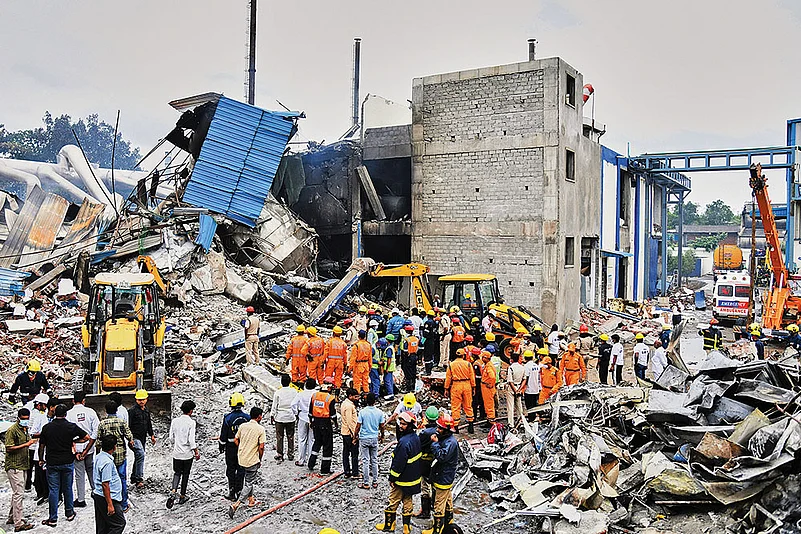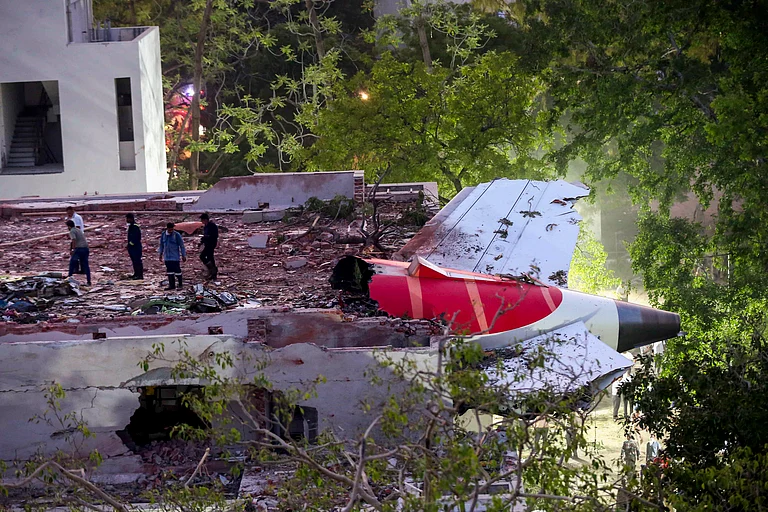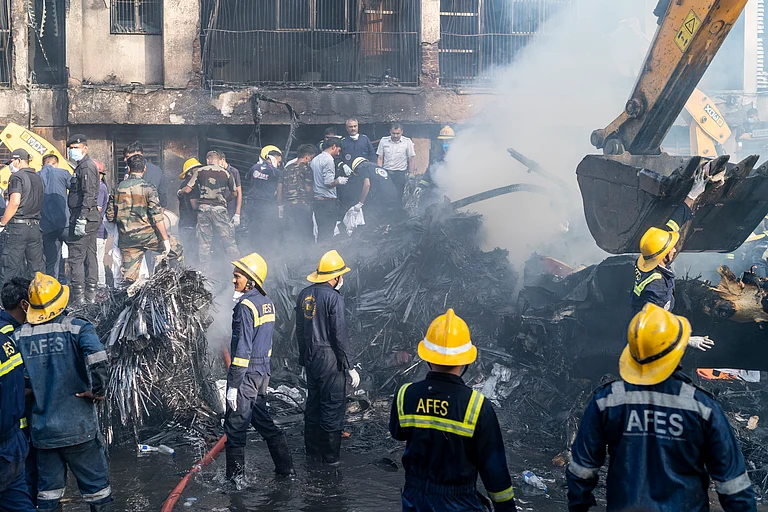Sri Ramya and Nikhil Reddy, both 29-year-olds, first met at the quality control deck of the now decimated Sigachi Industries located in Telangana’s Sangareddy district. She hailed from the Krishna district and had landed employment at the pharmaceutical factory after a stint at the Sri Padmavati Mahila Visvavidyalayam in Tirupati. Nikhil was from Jammalamadugu and had studied at the Sri Venkateswara University, also in the southern temple town. Their discreet love affair had been solemnised at a secret Arya Samaj wedding in April and a grand August ceremony was pencilled in to placate families, who were uneasy about their decision.
So Ramya swapped her usual 10 AM start for Nikhil’s dawn shift on June 30, hoping to steal a little more time together on the factory floor. At 9:10 AM the factory’s dryer blew in a shattering explosion, scattering metal, powder, human limbs... and the couple’s careful plans across the yard. Their love story ended where it began, on the Sigachi Industries quality control deck, which is now smashed to smithereens.
Almost a week after the blast that levelled Sigachi Industries and claimed 42 lives, officials concede that the factory was a catastrophe waiting to happen. Early inquiries point to worn machinery, under-trained staff and an absence of basic safety drills. District records show 34 bodies identified, 11 workers fighting for life and nine still untraced while forensic teams sift through 30 recovered body parts.
Eyewitnesses say the shock wave of the explosion cracked neighbouring walls and blew out windows. Investigators now speak of ignored alarms, failed temperature sensors and a build-up of combustible dust that turned a routine shift into India’s worst pharmaceutical sector accident. Specialists tracing the chain of errors, list overheating, faulty gauges and gaps in monitoring as factors; each one a tragic link that snapped on July 1.

Investigations by forensic and environmental agencies indicate that the direct cause of the explosion was the thermal decomposition (ignition) of microcrystalline cellulose (MCC), a substance that ignites at temperatures above 399°C.
MCC, though safe as a food and drug additive, turns volatile in industrial settings. When reduced to fine dust and exposed to heat, it becomes highly combustible, with even minor sparks capable of triggering violent dust explosions, experts warn. Such a dust explosion may have collapsed the whole facility and resulted in the deaths of workers, investigators initially surmise. Shikha Goel, Director of the Telangana Forensic Science Laboratory, concurs, stating that the overheating of a flammable material is likely the cause of the dust explosion.
“The temperature rise that led to the thermal decomposition of MCC should have been displayed on the monitoring screens at the factory; however, it went unnoticed,” said A. V. Ranganath, the commissioner of the Hyderabad Disaster Management and Asset Protection Agency (HYDRAA), who inspected the factory after the disaster.
He said the alarm system failed to go off and the sensors did not pick up any warning signs. The death toll, he added, was likely higher because the blast struck during the shift change, when both night and day workers had crowded into the cramped dryer section.
“The area was congested because of the ongoing powder packing,” he explained.
As investigators hunt for answers inside the gutted plant, desperate families gather outside, clutching both, identification papers and fading slivers of hope, even as police stand firm at the barricades, telling them to check with hospitals for updates on those missing.
P. Justin, 20, had left home at 7 AM, brimming with hope for his first day at Sigachi Industries in Telangana’s Sangareddy district. By mid-morning, he was missing. The explosion, which ripped through the factory’s dryer section, killed 42, injuring dozens more.

When we visited the plant, police cordoned off the wreckage. Justin’s father, Ramdas, was stopped at the gate. In anguish, he slammed a stone against his own head. Beside him, Justin’s pregnant aunt Sujatha, who had raised him after his mother’s death, begged for answers. The boy who once promised to lift the family out of poverty had vanished in the dust. “He never answered my call that morning,” Sujatha said, her voice brittle. As police log DNA samples and morgues fill, Justin’s unanswered phone joins the silence that now hangs over Pashamylaram.
Ramdas says Beerappa, a friend who helped Justin land the job, is in the hospital with 90 per cent burns. For others, the wait is longer and colder. DNA teams are on-site collecting samples from grieving relatives while forensic crews sift through the debris, lifting scorched remains and sending them to Hyderabad for identification.
Like Justin, 26-year-old Rahul Sharma, an MSc graduate, was also new to his job in the company’s Quality Control Department. It had just been 10 months.
A day before the explosion, he had wondered to his uncle, Ashok Sharma, if he would get a pay raise after completing a year at work. “If he didn’t receive it, he planned to start looking for another job,” said Sharma.
Across the barricades the grief was raw, but inside autopsies have begun to tell a story. Regulatory and investigation agencies are now focussed on how a medication filler drug could flatten an entire factory.
K. Babu Rao, a former chief scientist at the Indian Institute of Chemical Technology, noted that the incident bore a resemblance to a typical dust explosion. He cautioned that “poorly maintained spray dryers are potential hazards”.
Cellulose dust ignites easily, with similar explosions reported in sugar units and crude drug plants in Andhra Pradesh.
An official from the Telangana State Pollution Control Board (TGPCB), requesting anonymity, supported these conclusions. He indicated that the explosion was likely caused by an obstruction in the spray dryer, resulting in increased pressure and temperature. He also mentioned that the maintenance of the equipment was inadequate.
G. Ravi, TGPCB member-secretary, states that while the facility is authorised to operate until 2027, “We will now issue a closure notice due to the fatalities and alleged violations.” A joint team from the boilers department and the factory inspectorate is currently assessing the technical aspects of the incident. “It is premature to assign complete blame, but significant questions are being raised,” Ravi noted.
Experts have now begun to flag weak regulations and lack of inspector accountability for failing to ensure factory safety.
“Spray dryers are subject to pressure vessel regulations and inspectors must confirm compliance with standard operating procedures. This incident is not typical; it is a significant industrial tragedy that requires a thorough reassessment of the entire inspection framework of pharma companies in India,” insists Babu Rao.
Before the deadly Sigachi Industries fiasco, major pharma blasts in the region involved Escientia BioPharma in 2024 (17 dead), Sahiti Pharma in 2023 (seven dead), and Laurus Labs in 2022 (four dead). “With 35 years of experience as a regulator and as the former Director General of Pharmexcil (Pharmaceuticals Export Promotion Council of India), I have never seen a pharmaceutical manufacturing incident lead to such a high death toll. This is likely the most significant pharmaceutical disaster the country has experienced to date,” states Ravi Udaya Bhaskar, Director General of the All India Drugs Control Officers Confederation.
According to the National Disaster Response Force (NDRF), the presence of hazardous substances has hindered their rescue efforts due to the emergence of metallic flames.
“The factory’s pancake-style collapse, marked by the sequential crumpling of floors, has caused persistent flames to erupt from beneath the debris,” an NDRF official said.
According to District Police Superintendent Paritosh Pankaj Mahesh, Sigachi Industries Pvt. Ltd. has a documented history of multiple compliance violations since its establishment.
The factory had been previously flagged for flouting safety norms, overworking staff and lacking basic protective gear. It operated without a fire department NOC and had no alarms, heat detectors or auto-shutdown system, according to Fire Department personnel. No recent third-party safety checks were done, adding to accusations of sloppiness. Crucially, the plant’s processing areas had no blast-resistant walls or roofs, heightening the risk to workers and worsening the explosion’s impact.
State industry officials say many factories flout basic safety norms despite clear mandates under the National Building Code, including fire escapes, audits and safety officers. Sigachi Industries, like others, failed to meet these minimum standards too.
Unfortunately, Sigachi Industries is not an isolated case. Data from the Labour Bureau shows that between 2008 and 2021, over 10,000 workers died and around 60,000 were injured in various industries across India. This averages out to one worker fatality every 12 hours and one injury every two hours. These statistics reflect documented incidents; the real numbers could be substantially higher, says Babu Rao.
Rajnala Sai Yashwant, whose father lost his life in the explosion, says that employees had repeatedly expressed concerns about the outdated machinery in the factory. In his police complaint, Yashwant claimed that management ignored requests to replace the obsolete equipment and continued to use it despite the clear dangers it posed.
The FIR filed after the accident states that the tragedy was a direct result of negligence, with investigators charging the company under sections related to culpable homicide not amounting to murder.
For families like Bheem Rao’s, the debate over accountability means little. Their world shifted in a second from the realm of hope to the pit of helplessness.
Just a day before the blast, 24-year-old Bheem Rao had travelled from Kamareddy district to join work at Sigachi Industries. He came back in good spirits. But the next morning’s explosion left him critically injured. “There is little hope,” said his wife, Sonu, clutching their five-month-old daughter, who waved her tiny arms, unaware of the disaster around her.
Since then, the family has been gripped by anxiety and despair. His sisters, brother-in-law and nephew rushed from Kamareddy to Hyderabad after hearing the news. For others from states like Bihar, Odisha, Madhya Pradesh and Andhra Pradesh, the journey has been just as long, uncertain and the wait, just as punishing.
After his visit to the factory following the accident, Amit Raj Sinha, managing director and CEO of Sigachi Industries, insisted, “The incident is not related to any reactor explosion, as was initially reported by the media. We do not use any solvents in our facility. I suspect that a dust explosion occurred in the dryer area; however, the investigation into the cause is still ongoing.” “At this time, we stand by our previous statement that a reactor explosion did not cause the incident,” a company statement also said.
The state chief secretary is currently leading an investigation into the incident, which involves a team of both experts and officials. Following the government’s announcement of this investigation team, Sigachi Industries stated that it would refrain from commenting on the exact cause of the accident, as doing so could influence the investigation.
As officials squabble over triggers and temperature thresholds, Justin’s family waits in grim silence at Pattancheru Hospital; for his remains and for answers. The 20-year-old from North Karnataka was the family’s sole earner. Around them, survivors and the bereaved carry stories laced with chance and grief. Rahul Kumar from Champaran in Bihar narrowly escaped after swapping shifts with Atul Kumar, who is now gone. “There were no alarms,” said Vikas Raj, mourning his roommate Shivji.
MORE FROM THIS ISSUE
K A Shaji is senior assistant editor, 카지노





















